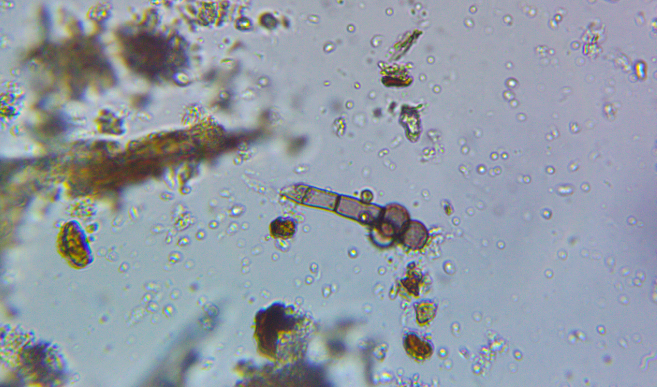What Are Soil Microbes? Who Are They and What Do They Do?
I was frustrated. There I was at my first soil health workshop. Moments before, I had learned of the wonders and abilities of soil biology. And yet, the test available would reduce these creatures to simple numbers on a page? I wanted to see them for myself, Not simply have faith that they were there doing their jobs.
Faith has its place, but the soil isn't one of them. We're going to walk through who these critters are but first I want to cover a couple of points:
These are not the only creatures in the soil. There are numerous things from viruses to archaea and things we have yet to discover. The ones I'll be talking about form the foundation for the food web in the soil.
Yes, there are plenty of bad microbes out there and you may have been taught that most of your life. But there's a lot of good microbes out there in the soil and in your body. When we keep conditions favorable for the beneficial microorganisms, they're able to outcompete the nasty ones. I'll talk more about that in a separate blog but for now I'll introduce you to the soil food web.
It all starts with the plant. Capturing sunshine and transforming it into sugar, the process of photosynthesis forms the basis of the soil food web. But a plant can't live on sugar alone. It needs N, P, K, Fe, Ca, Mg, S, and many more. There's plenty of these nutrients available in the soil. In fact, some say that there is no soil that is deficient in these nutrients; they are only in a form unavailable to the plant. There is something that can make them available. But that something needs to be fed. So, the plant releases upwards of 50% of all the sugar it creates into the soil, and along comes our first microbes.
Bacteria
Even if your soil has degraded to dirt, you likely have bacteria. I'm not saying that they're the cockroach of the soil - they're important, they're often the last one standing after all the disturbances! Bacteria form the first building block for soil structure, which I'll talk about in the next blog. They also play a key role in nutrient cycling. Because bacteria produce strong enzymes, they're able to extract nutrients from the soil. Nutrients that normally would be unavailable to plants.
Fungi
Did you envision a mushroom? Mushrooms are the fruiting body of a fungi, the tip of the iceberg. Most of the fungi is underground, growing in networks of fungal strands that we call hyphae. Believe it or not the largest known organism on earth is a fungi in Oregon. Unlike bacteria, fungi don’t handle soil disturbance well. In soils that are tilled or have chemical applications they are generally one of the limiting factors and are one of the keys to maximizing productivity (I'll discuss more about later). Like bacteria, fungi play an important role in nutrient cycling by producing strong acidic enzymes that also extract nutrients from the soil.
These fungal spores (brown spheres) have started to germinate. What we’re really interested in is the fungal hyphae, the longer brown structure. Because of the color, the thickness and the septa (cell wall down the center), this is probably a beneficial fungi.
The nutrients that bacteria and fungi extract from the soil still aren't in a plant available form. For those nutrients to become available, bacteria or fungi must die or be eaten by a predator. Bacteria and fungi are much more nutrient dense than a predator needs. The predator (nematode or protozoa) excretes the excess nutrients right there at the plant root where the bacteria and fungi were feeding. We call this the poop loop. You can think of these bacteria and fungi as little bags of fertilizer. But the bag of fertilizer isn't open until the bacteria or fungi get eaten by a predator. In order for the system to work you must have predators!
Protozoa
This may be a foreign word to you, but I will bet you've heard of amoeba, probably in the news. Contrary to what you've heard on the news about brain-eating amoeba and freshwater lakes, most amoeba are beneficial. Some are even artistic little creatures crafting themselves beautifully ornate homes out of silica particles. Others aren't as gifted known as naked amoebas; these blobs ooze around eating bacteria in their wake.
There’s two testate amoebas here. The larger one has created a beautiful, glass-like shell. The other is a golden testate amoeba (on the right side towards the middle). We also have a fungal spore (brown sphere).
Flagellates are another type of beneficial protozoa. Smaller in size, they have a long flagellum (tail-like propeller) that they use to pull themselves through the soil solution. Bumbling along searching for bacteria to eat. There's plenty of predators out there that eat bacteria which is good because our bacteria are numerous in the soil.
Then there's the protozoa we'd rather not see in our soil, ciliates. While the ciliates themselves aren't bad, they're telling us that conditions in the soil are no longer ideal for beneficial organisms. More specifically, they're telling us the oxygen levels in our soil are low, or anaerobic. If we're seeing ciliates, we know the nasty microbes aren't far away.
Nematodes
Speaking of nasty microbes, here's one that is probably the most misunderstood of them all (and my personal favorite). Yes, there are some nematodes that attack plant roots but the other 95% of nematodes are very beneficial, and under the right conditions, root feeding nematodes can be beneficial too. When root feeders are in low numbers in your soil they actually stimulate plant growth and increase plant production. The key is to have someone keeping them in check. That's where beneficial nematodes come in. We classify nematodes by what they eat. For the not-so-beneficials we have root feeders and switchers.
One of the good ones, this is a Bacterial Feeder/potential Omnivorous nematode. We identify what these nematodes eat based on their mouth shapes and internal digestive organs.
Switchers are generally fungal feeding nematodes, which are good. Remember the poop loop? But what happens if we lose the fungi in our soil, say, to a fungicide? Then the switchers will switch their food source to plant roots, hence the name, switcher.
For beneficial nematodes, we have bacterial feeders, fungal feeders, and omnivorous nematodes which eat all kinds of things that will fit in its mouth. Interestingly, these beneficial nematodes will physically protect the plant's roots from root feeding nematodes. It's almost as though they understand that the plant root is feeding their food source! A little nematode has a better understanding of ecology than a lot of us people! The one nematode I haven't mentioned is the one most commonly lacking in our soil. In her book For the Love of Soil, Nicole Masters refers to this nematode as the “canary in the mines of soil health”. It’s presence can be used as an indicator of soil health. It's the predatory nematode. Predatory nematodes eat other nematodes but their favorite food source? Root-feeding nematodes.
A bacterial feeding nematode. Several bacteria (cocci) in the background. These are the out of focus circles.
It's easy to label a critter “good” or “bad”. But like most things, the soil really isn’t black and white. We’re finding microbes that are known to be detrimental to our plants can actually be beneficial in the presence of certain microbes. This is a truly mind-blowing subject; I’ll be talking more about this later! So is it really the critter that's the problem? Or is it when the microbe gets out of hand that it becomes an issue? It's all about ensuring we have the diversity in our soil food web, and “beneficial” microbes there to keep everything in check. To do so, we've got to have the right conditions in our soil. So how do we create the right soil habitat for beneficial microorganisms? We'll be covering that in the next article.





